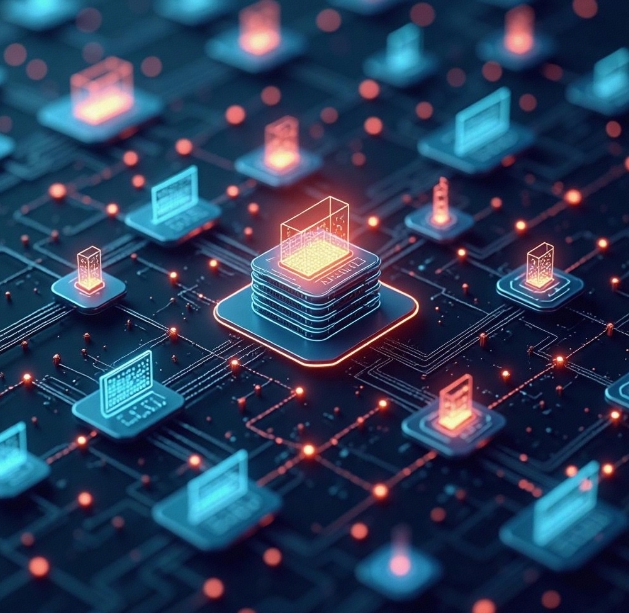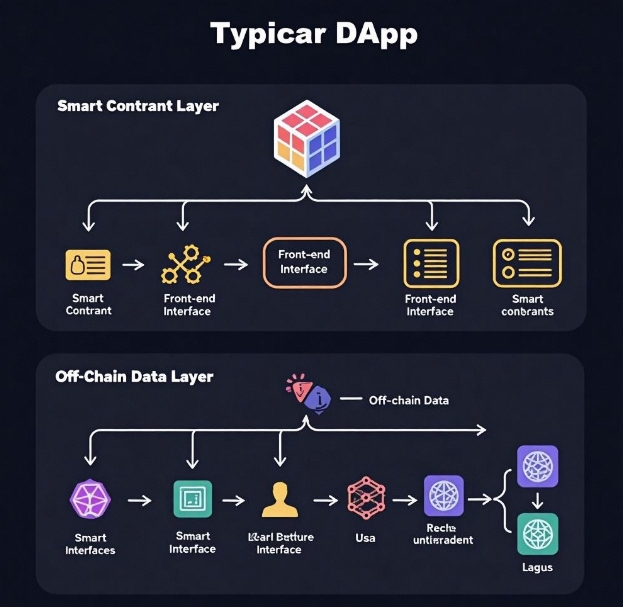Off-Chain Data Processing and On-Chain Interaction Implementation Methods in DApp Development
- latest articles
- 1.DApp Development & Customization: Merging Diverse Market Needs with User Experience 2.Analysis of the Core Technical System in DApp Project Development 3.How to achieve cross-chain interoperability in Web3 projects? 4.How does the tokenization of points reconstruct the e-commerce ecosystem? 5.How to Set and Track Data Metrics for a Points Mall? 6.What is DApp Development? Core Concepts and Technical Analysis 7.Inventory of commonly used Web3 development tools and usage tips 8.Development of a Distribution System Integrated with Social E-commerce 9.Six Key Steps for Businesses to Build a Points Mall System 10.What is DApp Development? A Comprehensive Guide from Concept to Implementation
- Popular Articles
- 1.Future Trends and Technology Predictions for APP Development in 2025 2.Analysis of the DeFi Ecosystem: How Developers Can Participate in Decentralized Finance Innovation 3.From Zero to One: How PI Mall Revolutionizes the Traditional E-commerce Model 4.DAPP Development | Best Practices for Professional Customization and Rapid Launch 5.Recommended by the Web3 developer community: the most noteworthy forums and resources 6.From Cloud Computing to Computing Power Leasing: Building a Flexible and Scalable Computing Resource Platform 7.How to Develop a Successful Douyin Mini Program: Technical Architecture and Best Practices 8.Shared Bike System APP: The Convenient Choice in the Era of Smart Travel 9.How to Create a Successful Dating App: From Needs Analysis to User Experience Design 10.From Design to Development: The Complete Process of Bringing an APP Idea to Life
Decentralized Applications (DApps), as one of the applications of blockchain technology, have gained widespread attention in recent years. Unlike traditional centralized applications, DApps rely on blockchain technology to achieve decentralized data storage and business logic, ensuring that users can interact without third-party intermediaries. The development process of DApps involves challenges across multiple technical layers, among which off-chain data processing and on-chain interaction are two critical components.
The implementation of off-chain data processing and on-chain interaction is key to ensuring that DApps are efficient, reliable, and provide a good user experience. On-chain interaction involves the processing and validation of data on the blockchain, while off-chain data processing involves systems outside the blockchain, such as servers and storage, to enhance the performance and functionality of DApps. This article will delve into the implementation methods of off-chain data processing and on-chain interaction in DApp development, analyze their respective roles in DApps, and provide some best practices and technical solutions.
1. DApp Architecture Overview
Before understanding off-chain data processing and on-chain interaction, it is essential to first grasp the basic architecture of a DApp. A typical DApp architecture generally consists of three parts:
Smart Contract Layer (On-Chain): Smart contracts are the core of a DApp; they are code that runs on the blockchain. Smart contracts define the application's business logic and are responsible for executing it. They ensure transaction transparency, immutability, and automation. Smart contracts interact with data on the blockchain, such as reading and writing data.
Frontend User Interface Layer: This is the part of the DApp that interacts with users. Users interact with the DApp through a browser-based interface, typically using libraries like Web3.js or Ethers.js to communicate with smart contracts.
Off-Chain Data Layer:To improve efficiency and scalability, DApps often need to utilize off-chain data processing. The off-chain data layer includes databases, caches, API servers, etc. The off-chain data layer is not directly stored on the blockchain but can interact with the blockchain through various technologies, providing faster and more flexible data access.
2. The Necessity of Off-Chain Data Processing
The inherent design and structure of blockchain determine its natural limitations in certain aspects. One of the most significant limitations is its throughput and storage capacity. Since every blockchain node needs to store all transaction records, the storage and processing capabilities of the blockchain are often limited. Therefore, much of the data in DApps is not suitable for complete storage on the blockchain, especially data that does not require frequent updates or queries.
The main goal of off-chain data processing is to store such data in off-chain databases or file systems to reduce the burden on on-chain storage and computation, while improving the performance and response speed of the application. Methods of off-chain data processing include, but are not limited to, the following:
Database Storage: DApps can use traditional databases (such as MySQL, PostgreSQL, MongoDB, etc.) to store non-core business data. For example, user personal information, transaction records, historical data, etc., can be stored in off-chain databases. Off-chain databases support efficient queries and operations, significantly enhancing the application's response speed.
Distributed File Storage: For DApps that need to store large amounts of unstructured data (such as images, videos, files, etc.), distributed storage systems like IPFS (InterPlanetary File System) can be used. IPFS is a decentralized file storage protocol that achieves decentralized data storage by splitting files into fragments and storing them across multiple nodes. DApps can store data on IPFS and record the file addresses on the blockchain via hash values.
Caching Mechanisms: For data that requires frequent access, off-chain caching mechanisms can significantly improve DApp performance. For example, using caching technologies like Redis allows hot data to be stored in memory, reducing frequent access to databases or the blockchain and improving response speed.
Events and Logs:The off-chain event and logging system can also serve as part of data processing. During the use of DApps, many operations trigger events that can be recorded off-chain and provide data support for subsequent operations. For example, when a user completes a transaction, the DApp can record the detailed information of this transaction and store it off-chain.
3. Implementation Methods of On-Chain Interactions
On-chain interactions refer to the interactions between DApps and the blockchain, primarily involving reading data from and writing data to the blockchain. The deployment and invocation of smart contracts are at the core of on-chain interactions. Typically, the frontend of a DApp communicates with smart contracts using libraries such as Web3.js or Ethers.js. The following are several common methods of on-chain interactions:
Deployment and Invocation of Smart Contracts: Smart contracts are deployed and executed through the blockchain's consensus mechanism. DApp developers write smart contracts and deploy them to the blockchain network. The frontend application can then invoke functions in the smart contracts using Web3.js or Ethers.js to implement the DApp's business logic.
Smart contract invocations are generally divided into two types:
Reading Data (Query Operations): Read operations do not alter the state of the blockchain; they only retrieve data stored on the blockchain. Read operations are typically free as they do not consume computational resources or storage space.
Writing Data (Transaction Operations): Write operations involve modifying data on the blockchain and usually require payment of a transaction fee (Gas fee). Write operations typically trigger logic within smart contracts, changing the state of the blockchain.
Event Monitoring and On-Chain Notifications: On the blockchain, smart contracts can trigger events, which can be used to notify the DApp's frontend of certain state changes. The frontend application monitors events on the blockchain to promptly obtain updates to on-chain data. For example, when a user's transaction is successfully submitted, the smart contract emits an event, and the frontend can listen for this event and update the interface accordingly.
Integration of Blockchain and Off-Chain Data:In many DApps, on-chain and off-chain data interact with each other. Changes in smart contract data may affect off-chain data processing, and conversely, updates to off-chain data may trigger on-chain interactions. For example, a DApp can use smart contracts to trigger certain off-chain operations (such as updating records in a database), while off-chain systems can also monitor on-chain events to trigger corresponding business logic.
4. Coordination Between Off-Chain Data and On-Chain Interactions
The coordination between off-chain data processing and on-chain interactions is crucial, as they need to work together to ensure the efficient operation and data consistency of DApps. In DApp development, common coordination methods include the following:
Using Oracles: Oracles are an important technology for bringing off-chain data onto the blockchain. Since smart contracts can only access on-chain data, they cannot directly retrieve data from outside the chain. Oracles connect off-chain data with on-chain interactions by fetching data from external systems and passing it to smart contracts. For example, DeFi applications may need to obtain price information for certain assets; oracles can deliver this information to smart contracts for price verification and transaction execution.
Off-Chain Computation and On-Chain Verification: Certain complex computations may need to be performed off-chain and then verified on the blockchain. For instance, in some DApps, user actions may involve complex calculations (such as algorithmic computations in prediction markets). These computations can be completed off-chain, with the results and relevant evidence submitted to the blockchain for final verification and storage.
Cross-Chain Interactions: With the development of multiple blockchains, cross-chain technology continues to evolve. Collaboration between on-chain interactions and off-chain data processing across different blockchains has become an important topic in DApp development. Through cross-chain protocols, DApps can achieve data sharing and interactions between different blockchains, while leveraging off-chain data processing to enhance the overall system performance.
5. Summary and Outlook
Off-chain data processing and on-chain interactions in DApps are core components of building efficient and reliable decentralized applications. Off-chain data processing enhances DApp performance and user experience by utilizing traditional databases, distributed storage systems, and caching mechanisms. On-chain interactions rely on the powerful capabilities of smart contracts and blockchain to ensure data transparency and immutability.
In the future, as technology continues to advance, the collaboration between off-chain and on-chain mechanisms will become increasingly complex. How to optimize DApp performance and scalability while maintaining decentralization will be a significant challenge for developers. Through continuous innovation and improvement, DApps will play an important role in more fields, promoting the widespread adoption and practical implementation of decentralized applications.
-

DApp Development & Customization: Merging Diverse Market Needs with User Experience
As blockchain technology matures and becomes more widespread, decentralized appl···
-

Analysis of the Core Technical System in DApp Project Development
With the rapid development of blockchain technology, decentralized applications ···
-

What is DApp Development? Core Concepts and Technical Analysis
With the rapid development of blockchain technology, decentralized applications ···

 Blockchain
Blockchain












